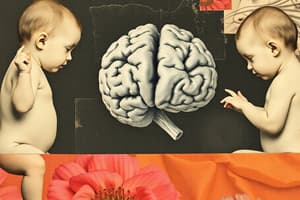Podcast
Questions and Answers
What was the difference in heart rate response between 5-month-old infants and 9-month-old infants when measured over the visual cliff?
What was the difference in heart rate response between 5-month-old infants and 9-month-old infants when measured over the visual cliff?
- 5-month-olds showed a deceleration, and 9-month-olds showed an increase (correct)
- Both 5-month-olds and 9-month-olds showed an increase
- 5-month-olds showed an increase, and 9-month-olds showed a deceleration
- Both 5-month-olds and 9-month-olds showed a deceleration
What did crawlers show compared to non-crawlers when it comes to wariness?
What did crawlers show compared to non-crawlers when it comes to wariness?
- There was no difference in wariness between crawlers and non-crawlers
- Non-crawlers showed more wariness
- Non-crawlers were more cognitively advanced than crawlers
- Crawlers showed more wariness (correct)
What does the text suggest about depth perception in newborn infants?
What does the text suggest about depth perception in newborn infants?
- Depth perception in newborns is still developing
- Newborn infants have no depth perception
- Newborns perceive depth only after crawling experience
- Newborn infants understand size constancy (correct)
Based on the text, what factor seems to determine whether an infant will cross the deep side of the visual cliff?
Based on the text, what factor seems to determine whether an infant will cross the deep side of the visual cliff?
What does the text suggest about wariness in infants regarding falling?
What does the text suggest about wariness in infants regarding falling?
How did the infants' crawling experience relate to their level of wariness according to the text?
How did the infants' crawling experience relate to their level of wariness according to the text?
Why did infants familiarized with the continuous event look longer at the two-object display?
Why did infants familiarized with the continuous event look longer at the two-object display?
What conflict arises from the data regarding infants' search behavior for hidden objects?
What conflict arises from the data regarding infants' search behavior for hidden objects?
What is a possible reason why infants might make search errors according to the text?
What is a possible reason why infants might make search errors according to the text?
Based on the text, what could be a reason for the violation-of-expectation studies showing early understanding of object permanence?
Based on the text, what could be a reason for the violation-of-expectation studies showing early understanding of object permanence?
What might cause an infant to look longer at a display that violates their familiar reasoning?
What might cause an infant to look longer at a display that violates their familiar reasoning?
How does familiarization impact infant reasoning in relation to real-world events?
How does familiarization impact infant reasoning in relation to real-world events?
What did Baillageron's truck and ramp study reveal about infants' perception of the 'impossible' event?
What did Baillageron's truck and ramp study reveal about infants' perception of the 'impossible' event?
What was the significance of the Drawbridge Study in understanding infants' object permanence?
What was the significance of the Drawbridge Study in understanding infants' object permanence?
How do nativist perspectives differ from Piaget's beliefs regarding infant object knowledge?
How do nativist perspectives differ from Piaget's beliefs regarding infant object knowledge?
How do young infants demonstrate their understanding in terms of support relationships between objects?
How do young infants demonstrate their understanding in terms of support relationships between objects?
What aspect of infants' cognitive development was challenged by the results of Baillageron's and the Drawbridge studies?
What aspect of infants' cognitive development was challenged by the results of Baillageron's and the Drawbridge studies?
In terms of infants' cognitive development, what role does the requirement for more support play as they grow older?
In terms of infants' cognitive development, what role does the requirement for more support play as they grow older?
What term is used to describe an infant's ability to understand that objects continue to exist even when they cannot be seen?
What term is used to describe an infant's ability to understand that objects continue to exist even when they cannot be seen?
At what age do infants typically begin to search for hidden objects, showing signs of object permanence?
At what age do infants typically begin to search for hidden objects, showing signs of object permanence?
What type of error tends to persist in infants between 8-12 months according to Piaget's research?
What type of error tends to persist in infants between 8-12 months according to Piaget's research?
Which technique involves testing infant expectations by presenting possible and impossible scenarios in object movement?
Which technique involves testing infant expectations by presenting possible and impossible scenarios in object movement?
What sign indicates that infants may be confused or distressed during the violation of expectation studies?
What sign indicates that infants may be confused or distressed during the violation of expectation studies?
What did T.G. Bower's studies primarily focus on regarding infant object knowledge?
What did T.G. Bower's studies primarily focus on regarding infant object knowledge?
What did Baillageron's truck and ramp study demonstrate about infants' perception of the 'impossible' event?
What did Baillageron's truck and ramp study demonstrate about infants' perception of the 'impossible' event?
What do nativist perspectives suggest about infant object knowledge according to the text?
What do nativist perspectives suggest about infant object knowledge according to the text?
In terms of infants' cognitive development, what role does the requirement for more support play as they grow older?
In terms of infants' cognitive development, what role does the requirement for more support play as they grow older?
What aspect of infants' reasoning was challenged by the results of Baillageron's and the Drawbridge studies?
What aspect of infants' reasoning was challenged by the results of Baillageron's and the Drawbridge studies?
How did Innate Core Knowledge theories contradict Piaget's beliefs regarding infant object knowledge?
How did Innate Core Knowledge theories contradict Piaget's beliefs regarding infant object knowledge?
Why do young infants require less support between objects for stability according to the text?
Why do young infants require less support between objects for stability according to the text?
Why did infants familiarized with the discontinuous event look longer at the one-object display?
Why did infants familiarized with the discontinuous event look longer at the one-object display?
What does the violation-of-expectation studies suggest about infants' understanding of object permanence?
What does the violation-of-expectation studies suggest about infants' understanding of object permanence?
What could explain the conflict between infants' search failure and their ability to understand object permanence?
What could explain the conflict between infants' search failure and their ability to understand object permanence?
Why do infants often display an 'a-not-b error' when searching for hidden objects?
Why do infants often display an 'a-not-b error' when searching for hidden objects?
Why might infants make search errors according to the text?
Why might infants make search errors according to the text?
How did infants reason about the display that violated their familiar reasoning?
How did infants reason about the display that violated their familiar reasoning?
What did the heart-rate change in 5-month-old infants when measured over the visual cliff suggest?
What did the heart-rate change in 5-month-old infants when measured over the visual cliff suggest?
What did the heart-rate change in 9-month-old infants when measured over the visual cliff indicate?
What did the heart-rate change in 9-month-old infants when measured over the visual cliff indicate?
What did even newborn infants understand about size constancy according to the text?
What did even newborn infants understand about size constancy according to the text?
What determines whether an infant will cross the deep side of the visual cliff according to the text?
What determines whether an infant will cross the deep side of the visual cliff according to the text?
Why did 9-month-old infants show an increase in heart rate over the deep part of the visual cliff?
Why did 9-month-old infants show an increase in heart rate over the deep part of the visual cliff?
What did even newborn infants seem to grasp according to the text?
What did even newborn infants seem to grasp according to the text?
Why did infants familiarized with the discontinuous event look longer at the one-object display?
Why did infants familiarized with the discontinuous event look longer at the one-object display?
What is a possible reason why infants might make search errors according to the text?
What is a possible reason why infants might make search errors according to the text?
How did infants reason about the display that violated their familiar reasoning?
How did infants reason about the display that violated their familiar reasoning?
What conflict arises from the data regarding infants' search behavior for hidden objects?
What conflict arises from the data regarding infants' search behavior for hidden objects?
On what basis did infants determine whether one or two objects were involved in an event according to the text?
On what basis did infants determine whether one or two objects were involved in an event according to the text?
What does it mean when infants look longer at a display that violates their familiar reasoning?
What does it mean when infants look longer at a display that violates their familiar reasoning?
Why do infants look longer at the impossible event in Baillageron's truck and ramp study?
Why do infants look longer at the impossible event in Baillageron's truck and ramp study?
What did the Drawbridge Study reveal about 5-month-old infants' understanding?
What did the Drawbridge Study reveal about 5-month-old infants' understanding?
How do nativist perspectives on infant object knowledge differ from Piaget's beliefs?
How do nativist perspectives on infant object knowledge differ from Piaget's beliefs?
What is the developmental trend observed regarding infants' requirement for support between objects as they grow older?
What is the developmental trend observed regarding infants' requirement for support between objects as they grow older?
What contradicts Piaget's beliefs about infant object knowledge according to the text?
What contradicts Piaget's beliefs about infant object knowledge according to the text?
Why do young infants require less support between objects for stability according to the text?
Why do young infants require less support between objects for stability according to the text?
Do infants exhibit spatial orientation skills during infancy?
Do infants exhibit spatial orientation skills during infancy?
What does response perseveration suggest as a reason for the a-not-b error in infants?
What does response perseveration suggest as a reason for the a-not-b error in infants?
What does evidence against response perseveration suggest about the a-not-b error?
What does evidence against response perseveration suggest about the a-not-b error?
What contributes to the memory limitations leading to the a-not-b error?
What contributes to the memory limitations leading to the a-not-b error?
How do infants' sophisticated memory abilities impact their success in tasks?
How do infants' sophisticated memory abilities impact their success in tasks?
At what age do infants typically begin to search for hidden objects, demonstrating object permanence?
At what age do infants typically begin to search for hidden objects, demonstrating object permanence?
What term describes the error that continues to persist in infants between 8-12 months according to Piaget?
What term describes the error that continues to persist in infants between 8-12 months according to Piaget?
What did T.G. Bower's violation-of-expectation studies primarily focus on in the 1960s-70s?
What did T.G. Bower's violation-of-expectation studies primarily focus on in the 1960s-70s?
What technique involves presenting infants with possible and impossible scenarios of object movement to test their expectations?
What technique involves presenting infants with possible and impossible scenarios of object movement to test their expectations?
What do infants show signs of when their expectations are violated during the violation-of-expectation studies?
What do infants show signs of when their expectations are violated during the violation-of-expectation studies?
What was a significant finding from Jean Piaget's research related to infants and hidden objects?
What was a significant finding from Jean Piaget's research related to infants and hidden objects?
Flashcards are hidden until you start studying




